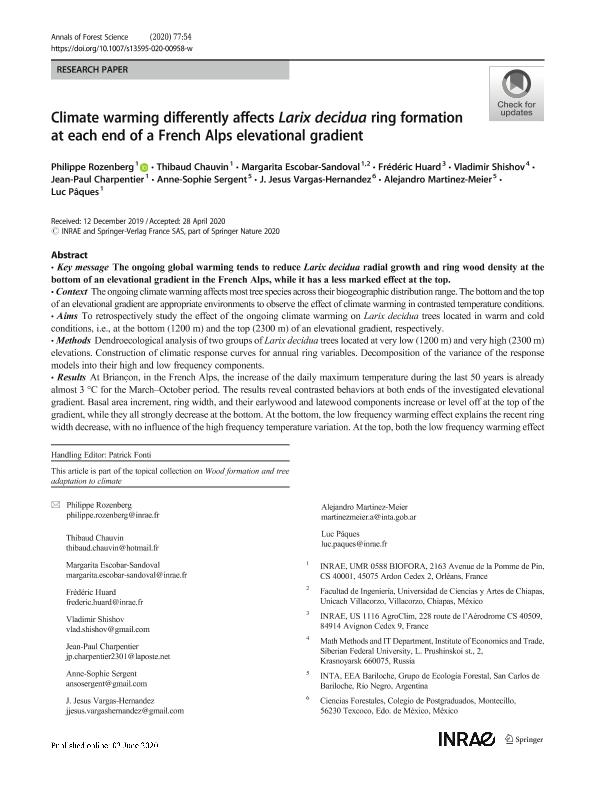Mostrar el registro sencillo del ítem
dc.contributor.author
Rozenberg, Philippe
dc.contributor.author
Chauvin, Thibaud
dc.contributor.author
Escobar Sandoval, Margarita
dc.contributor.author
Huard, Frédéric
dc.contributor.author
Shishov, Vladimir
dc.contributor.author
Charpentier, Jean Paul

dc.contributor.author
Sergent, Anne Sophie

dc.contributor.author
Vargas Hernandez, J. Jesus
dc.contributor.author
Martinez Meier, Alejandro
dc.contributor.author
Pâques, Luc
dc.date.available
2020-08-31T17:48:01Z
dc.date.issued
2020-06
dc.identifier.citation
Rozenberg, Philippe; Chauvin, Thibaud; Escobar Sandoval, Margarita; Huard, Frédéric; Shishov, Vladimir; et al.; Climate warming differently affects Larix decidua ring formation at each end of a French Alps elevational gradient; EDP Sciences; Annals of Forest Science; 77; 2; 6-2020; 1-20
dc.identifier.issn
1286-4560
dc.identifier.uri
http://hdl.handle.net/11336/112801
dc.description.abstract
The ongoing climate warming affects most tree species across their biogeographic distribution range. The bottom and the top of an elevational gradient are appropriate environments to observe the effect of climate warming in contrasted temperature conditions.AimsTo retrospectively study the effect of the ongoing climate warming on Larix decidua trees located in warm and cold conditions, i.e., at the bottom (1200 m) and the top (2300 m) of an elevational gradient, respectively.MethodsDendroecological analysis of two groups of Larix decidua trees located at very low (1200 m) and very high (2300 m) elevations. Construction of climatic response curves for annual ring variables. Decomposition of the variance of the response models into their high and low frequency components.ResultsAt Briançon, in the French Alps, the increase of the daily maximum temperature during the last 50 years is already almost 3 °C for the March?October period. The results reveal contrasted behaviors at both ends of the investigated elevational gradient. Basal area increment, ring width, and their earlywood and latewood components increase or level off at the top of the gradient, while they all strongly decrease at the bottom. At the bottom, the low frequency warming effect explains the recent ring width decrease, with no influence of the high frequency temperature variation. At the top, both the low frequency warming effect and the high frequency temperature effect explain each about half of the ring width variation encompassed by the model. Latewood density displays the same trend as ring width, while earlywood density decreases at both ends of the gradient.ConclusionSuch opposed trends of the radial growth time trends between the top (2300 m) and the bottom (1200 m) of the gradient reflects the respectively favorable and unfavorable effects of climate warming at such ends of this Larix decidua elevational gradient. We propose that the strong ring width decrease observed at the warmer bottom announces a coming dieback. The corresponding wood density decrease will affect wood hydraulic properties in a way that is unclear.
dc.format
application/pdf
dc.language.iso
eng
dc.publisher
EDP Sciences

dc.rights
info:eu-repo/semantics/openAccess
dc.rights.uri
https://creativecommons.org/licenses/by-nc-sa/2.5/ar/
dc.subject
CLIMATE WARMING
dc.subject
ELEVATIONAL GRADIENT
dc.subject
LARIX DECIDUA
dc.subject.classification
Ecología

dc.subject.classification
Ciencias Biológicas

dc.subject.classification
CIENCIAS NATURALES Y EXACTAS

dc.title
Climate warming differently affects Larix decidua ring formation at each end of a French Alps elevational gradient
dc.type
info:eu-repo/semantics/article
dc.type
info:ar-repo/semantics/artículo
dc.type
info:eu-repo/semantics/publishedVersion
dc.date.updated
2020-06-30T17:55:02Z
dc.identifier.eissn
1297-966X
dc.journal.volume
77
dc.journal.number
2
dc.journal.pagination
1-20
dc.journal.pais
Francia

dc.journal.ciudad
Paris
dc.description.fil
Fil: Rozenberg, Philippe. Institut National de la Recherche Agronomique; Francia
dc.description.fil
Fil: Chauvin, Thibaud. Institut National de la Recherche Agronomique; Francia
dc.description.fil
Fil: Escobar Sandoval, Margarita. Institut National de la Recherche Agronomique; Francia
dc.description.fil
Fil: Huard, Frédéric. Institut National de la Recherche Agronomique; Francia
dc.description.fil
Fil: Shishov, Vladimir. Siberian Federal University; Rusia
dc.description.fil
Fil: Charpentier, Jean Paul. Institut National de la Recherche Agronomique; Francia
dc.description.fil
Fil: Sergent, Anne Sophie. Instituto Nacional de Tecnología Agropecuaria. Centro Regional Patagonia Norte. Estación Experimental Agropecuaria San Carlos de Bariloche. Instituto de Investigaciones Forestales y Agropecuarias Bariloche. - Consejo Nacional de Investigaciones Científicas y Técnicas. Centro Científico Tecnológico Conicet - Patagonia Norte. Instituto de Investigaciones Forestales y Agropecuarias Bariloche; Argentina
dc.description.fil
Fil: Vargas Hernandez, J. Jesus. No especifíca;
dc.description.fil
Fil: Martinez Meier, Alejandro. Instituto Nacional de Tecnología Agropecuaria. Centro Regional Patagonia Norte. Estación Experimental Agropecuaria San Carlos de Bariloche. Instituto de Investigaciones Forestales y Agropecuarias Bariloche. - Consejo Nacional de Investigaciones Científicas y Técnicas. Centro Científico Tecnológico Conicet - Patagonia Norte. Instituto de Investigaciones Forestales y Agropecuarias Bariloche; Argentina
dc.description.fil
Fil: Pâques, Luc. Institut National de la Recherche Agronomique; Francia
dc.journal.title
Annals of Forest Science

dc.relation.alternativeid
info:eu-repo/semantics/altIdentifier/url/http://link.springer.com/10.1007/s13595-020-00958-w
dc.relation.alternativeid
info:eu-repo/semantics/altIdentifier/doi/http://dx.doi.org/10.1007/s13595-020-00958-w
Archivos asociados
